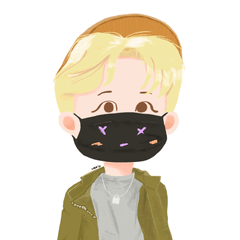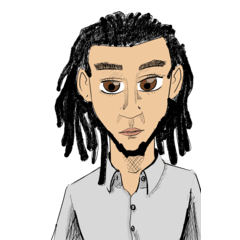How to Draw: Hands
Intro
Hands are famously considered the most challenging part of the human body to illustrate, often leading us to avoid drawing them completely. However, since hands are our primary means of interacting with the world, it becomes essential to acquire the skill of drawing them accurately. In this tutorial, we will go through key tricks and helpful guides for drawing and painting hands.
The Basic Proportions of the Hand
Dorsal Side of the Hand
The dorsal side refers to the back of the hand. When separated into two equal parts the middle finger equals the rest of the hand. It also forms an arc with the other fingers, connecting the knuckles, joints, and fingertips. The angle is gradually narrower as it moves closer to the hand's outside edge.
On this side, the fingers can be broken up into two equal pieces: from knuckle to joint and from joint to fingertip.
Palmar Side of the Hand
The palmar side refers to the front of the hand. The curve going through the knuckles, joints, and fingertips can also be observed from here. Although you might recognize that the length of the middle finger is no longer equal to the rest of the hand.
This is because, on the palmar side, the fingers are shorter. If you look at the back of your hand and stretch your fingers out you will notice that a web of skin connects them. This skin is where the fingers start at the palmar side meaning they look slightly shorter.
The Wrist
The wrist is a joint between the hand and the forearm. The forearm is made up of two bones, the ulna, and the radius. These bones are shaped in a way that creates small protrusions on each side of the wrist.
The one on the side of the little finger is more prominent because the ulna is located higher to the radius and closer to the skin.
When the hand is in a relaxed position, the wrist is positioned higher than the palm and forms a tilted connection with the knuckles rather than a straight one.
The Palm
Rather than fixating on anatomical details, it is important to first understand the basic shapes and rules. To start, focus on the palm as it serves as a base for all the other parts, and sketch a rough square. Our purpose here is to draw an impression of a hand only to locate and adjust it according to the perspective, we can add the necessary details afterward.
Notice how the wrist is above the palm and the line from the wrist to the knuckle is tilted.
Muscles of the palm create two prominent bumps The one near the thumb is bigger compared to the one near the pinky side. They especially become clear when the hand is facing up.
The Thumb
Compared to other fingers, the thumb moves more freely so it can be harder to locate it, however by using circular lines that pass through the joints of the index finger we can determine where the thumb will land in various types of movements.
When observed at the back of the hand, the thumb creates a distinct crease.
The Fingers
We can divide a finger into 3 pieces each separated by its joints. Since the fingers curve from their joints this allows us to easily depict that movement.
These parts are approximately the same in length although proportions slightly differ from finger to finger, especially for the little finger in which when divided into 3 pieces the top part is taller compared to the rest.
A realistic finger is not perfectly straight and has bumps where the joints are.
When curled up, the finger squishes into itself forming a curved line instead of a straight one.
Fingernails
Fingernails are mostly about perspective. Notice how you can see the tip of the fingernail curling the more the finger comes up. The same is true for cuticles.
The sides of the hand
Now that we learned all the components of the hand we can look at it from other angles to truly grasp it.
The thumb side
The palm of the hand has an angle to it. When the hand is in a relaxed position, it naturally curves inwards, causing some fingers to be positioned higher than others. The middle finger acts as the key determinant of this arrangement, as it is placed at the highest point. Therefore, when viewing the hand from the side of the thumb, the fingers that lie behind the middle finger are not visible, resulting in only two fingers being observable from this perspective.
Additionally, from this view, we can also observe the curves formed by the bones in the forearm.
The pinky side
Using the same logic we can see that the index finger is hidden when viewed from the pinky side, falling behind the middle finger. As a result, only three fingers are visible from this angle.
How a Fist Forms
Most hand actions can be predicted if we have an understanding of how the fingers should close and bend. This is why learning to draw a fist is crucial.
The fingers naturally curl inward when the hand is closing. and they squish together when they meet at the palm.
When the fist forms, the index finger pops outwards as the pinky and ring fingers burrow deeper into the palm, exposing the knuckles.
You can see from a top view how the fingers form a curve.The index finger is positioned higher because of its impact with the thumb.
We already talked about the side views for the hand and now we can see it curled up into a fist. Some things to note here are the number of fingers showing, the fingers curling inwards with an angle and the arm curling into the fist instead of forming a straight line.
Perspective
The many components of the hand and their independent movements from one another provide a real challenge when different perspectives are considered. To simplify this process we can use cubes to help us.
If the hand is moving away from us it should gradually get smaller.
Coloring
While there are many ways to color a hand, it often follows a specific color scheme. Typically, the hand exhibits a gradual shift in color, with the tips of the fingers becoming pinker, and the palm showing greenish or bluish colors in comparison to the rest of the hand.
We can study color more clearly in an example:
I first start with a lineart and color the base colors in.
Keeping the color scheme in mind we can put colors disregarding most of the shadow and light.
Now I add the necessary shadows and highlights. I also add the fingernails.
I now have the finished painting after cleaning and blending. Keep in mind that the parts of the cup that the hand touches are pink because light reflects on it.
Thank You
Thank you for reading this far, and I hope you found it enjoyable! Remember, understanding anatomy takes practice, and the most effective learning comes from using drawing references. Make sure to practice frequently, and I wish you the best of luck!
























Comment